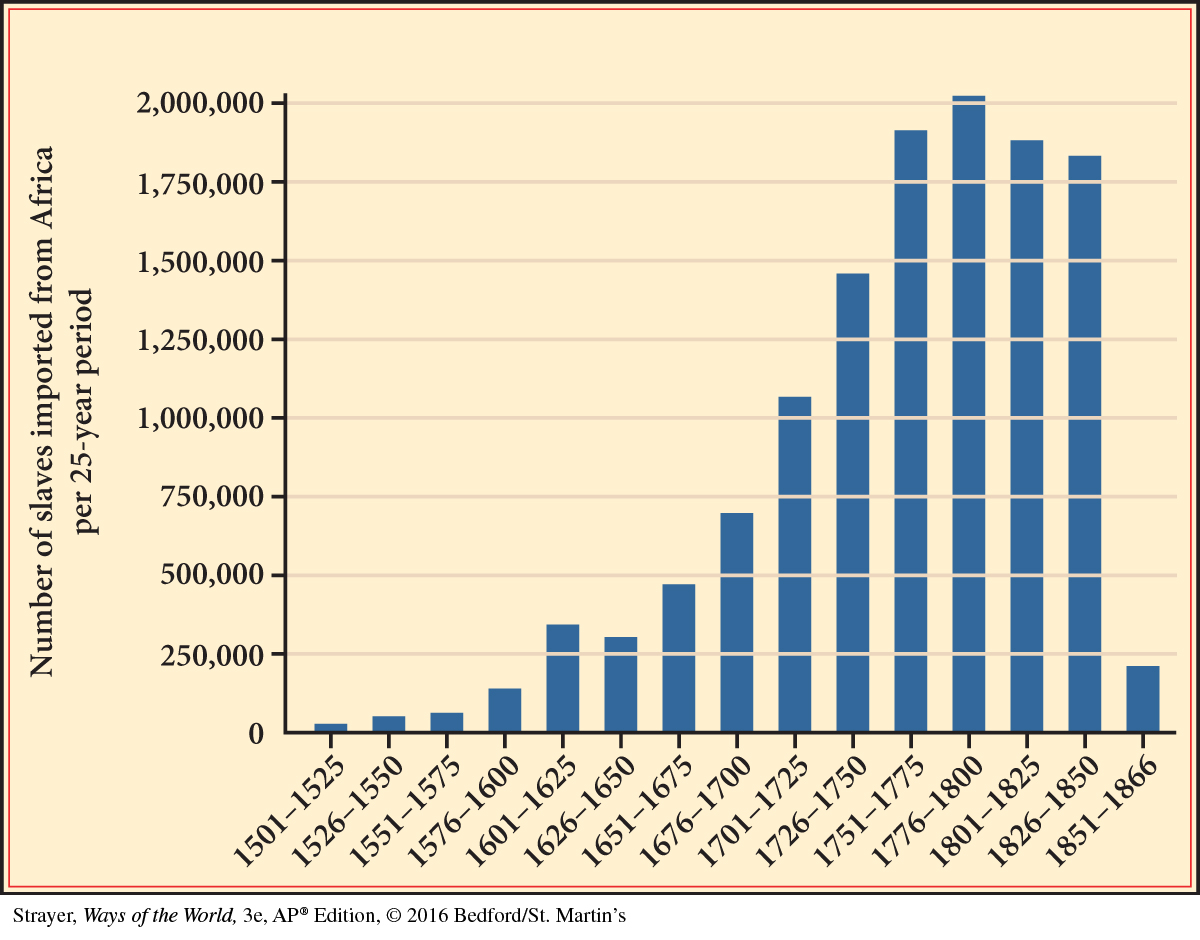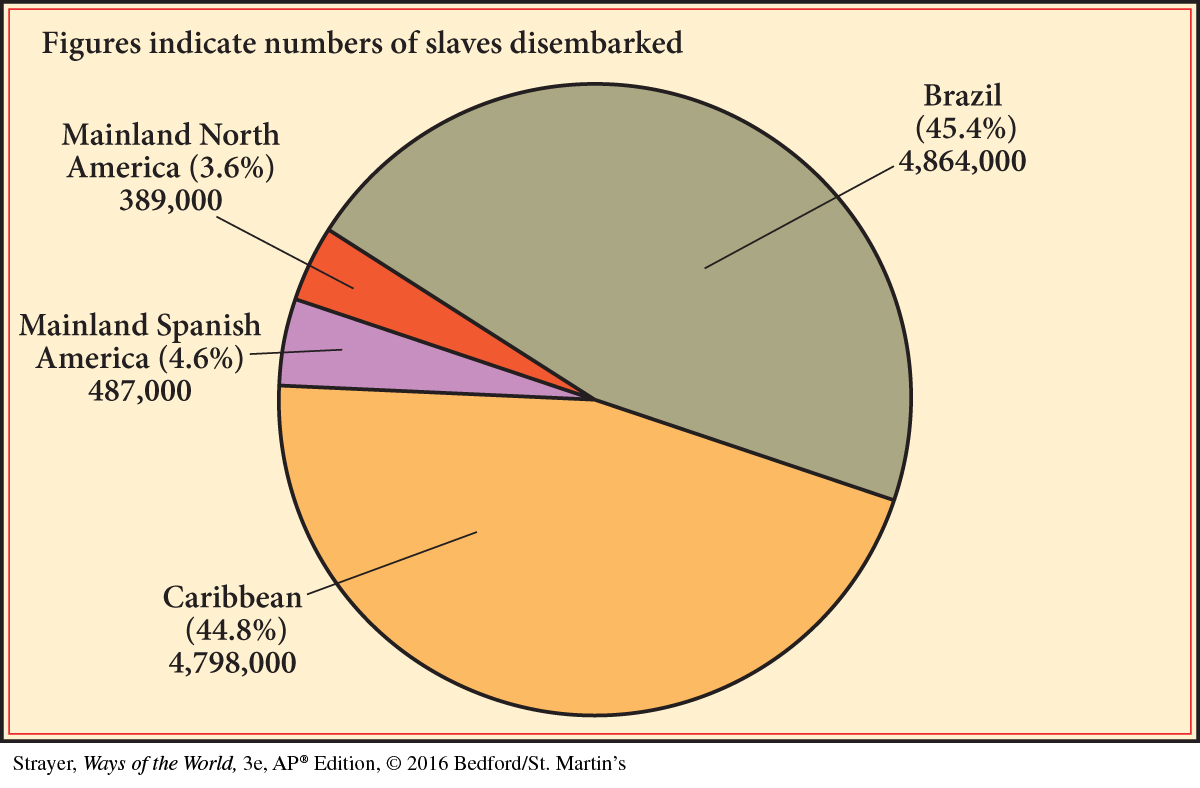Consequences: The Impact of the Slave Trade in Africa
From the viewpoint of world history, the chief outcome of the slave trade lay in the new transregional linkages that it generated as Africa became a permanent part of an interacting Atlantic world. Millions of its people were now compelled to make their lives in the Americas, where they made an enormous impact both demographically and economically. Until the nineteenth century, they outnumbered European immigrants to the Americas by three or four to one, and West African societies were increasingly connected to an emerging European-
AP® EXAM TIP
Charts and graphs frequently show up on the AP® exam, so develop your skills in “reading” all parts of these documents for information like trends over time.
SNAPSHOTThe Slave Trade in Numbers (1501–1866)35
The Rise and Decline of the Slave Trade

The Destinations of Slaves

Guided Reading Question
▪CHANGE
In what different ways did the Atlantic slave trade transform African societies?
Although the slave trade did not cause Africa to experience the kind of population collapse that occurred in the Americas, it certainly slowed Africa’s growth at a time when Europe, China, and other regions were expanding demographically. Scholars have estimated that sub-Saharan Africa represented about 18 percent of the world’s population in 1600, but only 6 percent in 1900.36 A portion of that difference reflects the slave trade’s impact on Africa’s population history.
Beyond the loss of millions of people over four centuries, the slave trade produced economic stagnation and social disruption. Economically, the slave trade stimulated little positive change in Africa because those Africans who benefited most from the traffic in people were not investing in the productive capacities of their societies. Although European imports generally did not displace traditional artisan manufacturing, no technological breakthroughs in agriculture or industry increased the wealth available to these societies. Maize and manioc (cassava), introduced from the Americas, added a new source of calories to African diets, but the international demand was for Africa’s people, not its agricultural products.
Socially too, the slave trade shaped African societies. It surely fostered moral corruption, particularly as judicial proceedings were manipulated to generate victims for the slave trade. A West African legend that cowrie shells, a major currency of the slave trade, grew on corpses of the slaves was a symbolic recognition of the corrupting effects of this commerce in human beings. During the seventeenth century, a movement known as the Lemba cult appeared along the lower and middle stretches of the Congo River. It brought together the mercantile elite — chiefs, traders, caravan leaders — of a region heavily involved in the slave trade. Complaining about stomach pains, breathing problems, and sterility, they sought protection against the envy of the poor and the sorcery that it provoked. Through ritual and ceremony as well as efforts to control markets, arrange elite marriages, and police a widespread trading network, Lemba officials sought to counter the disruptive impact of the slave trade and to maintain elite privileges in an area that lacked an overarching state authority.
African women felt the impact of the slave trade in various ways, beyond those who numbered among its transatlantic victims. Since far more men than women were shipped to the Americas, the labor demands on those women who remained increased substantially, compounded by the growing use of cassava, a labor-intensive import from the New World. Unbalanced sex ratios also meant that far more men than before could marry multiple women. Furthermore, the use of female slaves within West African societies also grew as the export trade in male slaves expanded. Retaining female slaves for their own use allowed warriors and nobles in the Senegambia region to distinguish themselves more clearly from ordinary peasants. In the Kongo, female slaves provided a source of dependent laborers for the plantations that sustained the lifestyle of urban elites. A European merchant on the Gold Coast in the late eighteenth century observed that every free man had at least one or two slaves.
For much smaller numbers of women, the slave trade provided an opportunity to exercise power and accumulate wealth. In the Senegambia region, where women had long been involved in politics and commerce, marriage to European traders offered advantage to both partners. For European male merchants, as for fur traders in North America, such marriages afforded access to African-operated commercial networks as well as the comforts of domestic life. Some of the women involved in these cross-cultural marriages, known as signares, became quite wealthy, operating their own trading empires, employing large numbers of female slaves, and acquiring elaborate houses, jewelry, and fashionable clothing.
Furthermore, the state-building enterprises that often accompanied the slave trade in West Africa offered yet other opportunities to a few women. As the Kingdom of Dahomey (deh-HOH-mee) expanded during the eighteenth century, the royal palace, housing thousands of women and presided over by a powerful Queen Mother, served to integrate the diverse regions of the state. Each lineage was required to send a daughter to the palace even as well-to-do families sent additional girls to increase their influence at court. In the Kingdom of Kongo, women held lower-level administrative positions, the head wife of a nobleman exercised authority over hundreds of junior wives and slaves, and women served on the council that advised the monarch. The neighboring region of Matamba was known for its female rulers, most notably the powerful Queen Nzinga (1626–1663), who guided the state amid the complexities and intrigues of various European and African rivalries and gained a reputation for her resistance to Portuguese imperialism.
Within particular African societies, the impact of the slave trade differed considerably from place to place and over time. Many small-scale kinship-based societies, lacking the protection of a strong state, were thoroughly disrupted by raids from more powerful neighbors, and insecurity was pervasive. Oral traditions in southern Ghana, for example, reported that “there was no rest in the land,” that people went about in groups rather than alone, and that mothers kept their children inside when European ships appeared.37 Some larger kingdoms such as Kongo and Oyo slowly disintegrated as access to trading opportunities and firearms enabled outlying regions to establish their independence. (For an account of one young man’s journey to slavery and back, see Zooming In: Ayuba Suleiman Diallo.)
AP® EXAM TIP
Remember that merchants in the Atlantic slave trade consisted of three groups: Europeans, European colonists in the Americas, and Africans.
However, African authorities also sought to take advantage of the new commercial opportunities and to manage the slave trade in their own interests. The Kingdom of Benin, in the forest area of present-